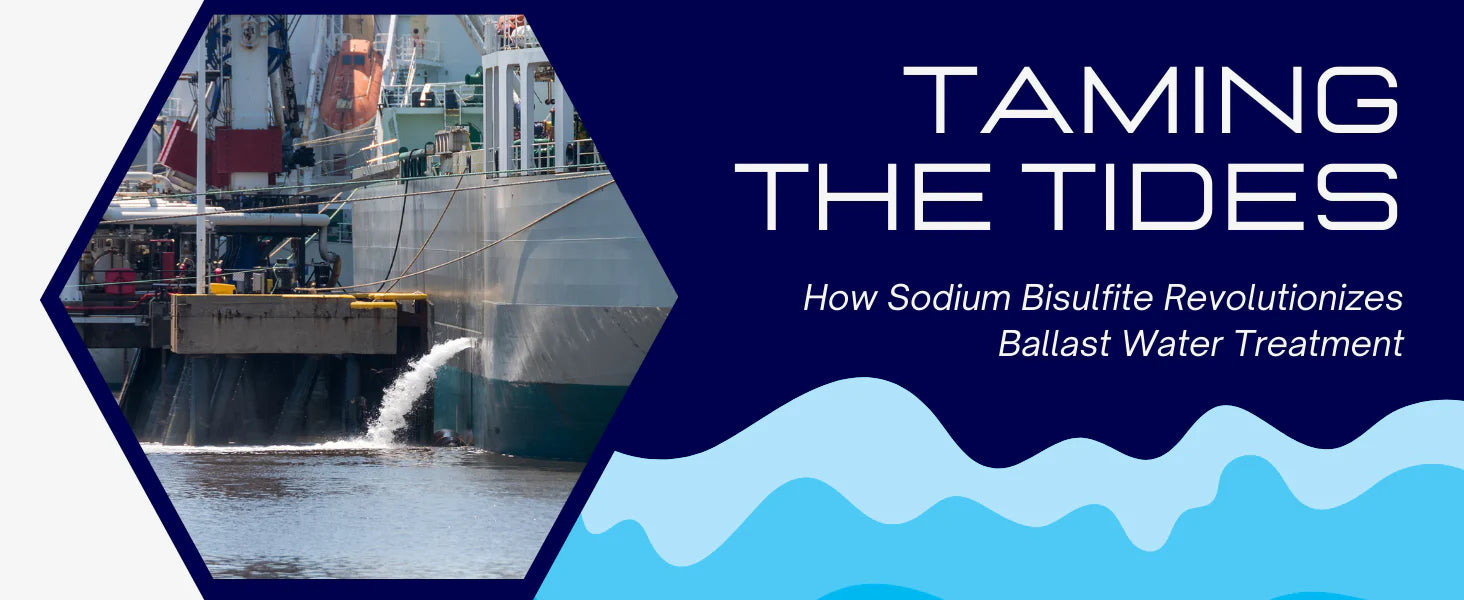
Taming the Tides: How Sodium Bisulfite Revolutionizes Ballast Water Treatment
Summary
The global shipping industry is the lifeblood of commerce, but it carries an inherent ecological risk: the transfer of invasive aquatic species via ballast water. To combat this threat, modern Ballast Water Management Systems (BWMS) employ sophisticated disinfection technologies. However, many of these systems require a crucial second step to ensure environmental safety upon discharge. This is the domain of Sodium Bisulfite. This definitive technical guide explores the science of dechlorination, details the critical role of Sodium Bisulfite in achieving regulatory compliance, and provides the expert knowledge needed for its safe and effective application.
The Ballast Water Problem: A Global Ecological Threat
Large vessels take on and discharge enormous quantities of water to maintain stability and trim. This ballast water contains a cocktail of local marine life—from microscopic bacteria and algae to larval forms of larger organisms. When this water is discharged in a distant port, these non-native organisms can become invasive, outcompeting local species, disrupting the food web, and causing billions of dollars in ecological and economic damage.
In response, the International Maritime Organization (IMO) established the Ballast Water Management Convention, which mandates that all ocean-going vessels must be equipped with an approved BWMS to treat their ballast water before discharge.
The Two-Step Solution: Disinfection and Neutralization
Many of the most effective and widely adopted BWMS use a powerful oxidant to kill organisms during the voyage. The most common method is electro-chlorination, where seawater is passed through an electrolytic cell to generate Sodium Hypochlorite (bleach) in-situ. This process creates a "Total Residual Oxidant" (TRO) level in the ballast tanks, which is highly effective at disinfection.
However, discharging water containing residual chlorine is highly toxic to marine life and is strictly prohibited. This creates the need for a second, critical step just before discharge: neutralization.
The Role of Sodium Bisulfite: A Powerful Reducing Agent
This is where Sodium Bisulfite (NaHSO₃) comes in. As a potent reducing agent, it is the industry standard for dechlorination. It works by rapidly and completely neutralizing the residual chlorine (the oxidizing agent).
NaHSO₃ + NaOCl → NaHSO₄ + NaCl
In this reaction, the toxic Sodium Hypochlorite (NaOCl) is instantly converted into Sodium Bisulfate (NaHSO₄) and Sodium Chloride (NaCl), or common salt. Both of these resulting compounds are harmless to the marine environment at the concentrations involved. This allows the vessel to discharge water that is both biologically safe (no invasive species) and chemically safe (no toxic chlorine).
Practical Application in a Ballast Water Management System (BWMS)
In a typical electro-chlorination BWMS, the application of Sodium Bisulfite is an automated and precisely controlled process.
- Disinfection Phase (Ballasting): As the ship takes on ballast water, it is passed through the electro-chlorination unit, which doses it with a specific concentration of chlorine to kill organisms.
- Voyage Phase: The chlorinated water is held in the ballast tanks for the duration of the voyage, ensuring sufficient contact time for a complete kill.
- Neutralization Phase (De-ballasting): As the ship prepares to discharge the ballast water, the main ballast pumps direct the water through the discharge line. A sensor in this line continuously measures the TRO (chlorine) level.
- Automated Dosing: This TRO sensor sends a signal to a chemical dosing pump. The pump injects a precise amount of Sodium Bisulfite solution into the line just upstream of the sensor. The system is designed to dose just enough bisulfite to completely neutralize the chlorine, achieving a near-zero TRO level at the final discharge point.
Why Purity Matters
The reliability of the automated dosing system depends on the consistent quality and concentration of the Sodium Bisulfite solution. Using a high-quality, stable product like ACS Grade Sodium Bisulfite 40% Solution ensures that the dosing calculations are accurate and the neutralization is complete, guaranteeing regulatory compliance with every discharge.
Buyer's Guide: Understanding Sodium Bisulfite Products
| Product Form | Key Characteristics | Primary Advantage | Ideal Use Case |
|---|---|---|---|
| 40% Solution | A stabilized, ready-to-use liquid. | Convenience and safety. Eliminates the need for on-board mixing of powders. | The standard for most commercial BWMS, providing direct feed to dosing pumps. |
| Anhydrous (Powder/Granular) | A solid, concentrated form. | Lower shipping weight and smaller storage footprint. | Vessels with on-board mixing systems or for other industrial applications like water treatment on land. |
MANDATORY Safety Protocols for Handling Sodium Bisulfite
Sodium Bisulfite is a hazardous chemical that can release toxic sulfur dioxide (SO₂) gas under certain conditions. It must be handled with care according to the Safety Data Sheet (SDS).
- Acid Hazard: Never mix Sodium Bisulfite with strong acids. This will cause the rapid release of toxic and corrosive sulfur dioxide gas, which poses a severe inhalation hazard.
- Personal Protective Equipment (PPE): Always wear chemical-resistant gloves, splash-proof safety goggles, and protective clothing. A respirator with an appropriate cartridge may be required when handling powders or in case of a spill.
- Ventilation: Ensure all handling, mixing, and storage is performed in a well-ventilated area to prevent the accumulation of any potential off-gassing.
- Storage: Store in a cool, dry, well-ventilated area away from acids and strong oxidizing agents. Ensure containers are kept tightly sealed.




